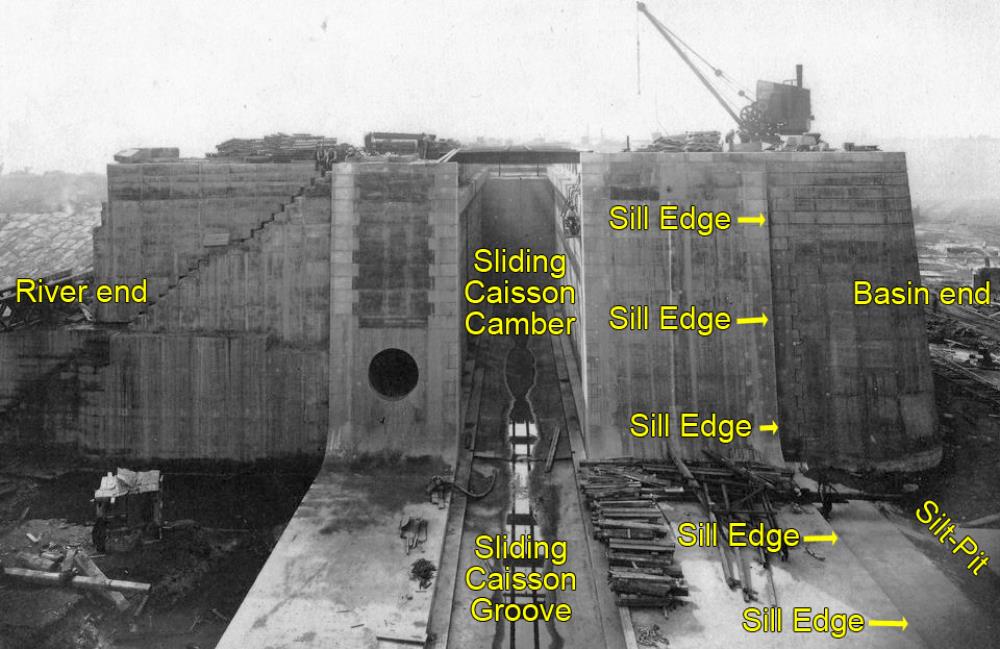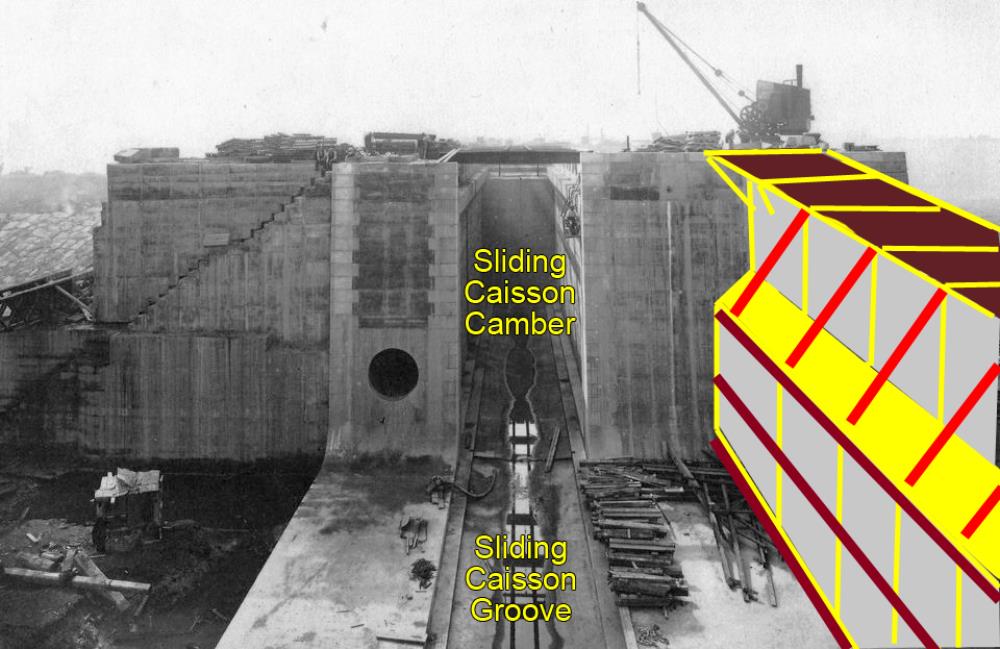19 – Secondary floating caisson for the emergency opening
| < 18 – Floating Caissons | Δ Index | 20 – Land Reclamation, Excavation and Dredging > |
This caisson is mentioned in the records, but there is no explanation as to its purpose or position.
It was probably provided as a back-up in case there was any problem with the emergency exit sliding caisson. If this caisson failed to close, the entire inner basin would empty as the tide fell. A secondary floating caisson could be moved into position to seal the entrance.
 Annotated image of the emergency entrance under construction
Annotated image of the emergency entrance under construction
This image of the emergency entrance under construction shows next to the silt-pit a sill edge which continues to the top of the wall. I believe that this is the sealing edge for the floating caisson. It is the same profile as the floating caisson groove in Dock No1.
 How a floating caisson might look positioned against the sill edge in the emergency entrance.
How a floating caisson might look positioned against the sill edge in the emergency entrance.
A floating caisson placed against this edge would seal the basin, because the water level inside the basin is always at high tide level, so the caisson is pushed against the sill edge. No 1 dock needs a two-sided groove because either side of its floating caisson can be pumped dry, so the caisson is pushed either way against the edge of the groove.
 Suggested position of the floating caisson groove in the emergency entrance
Suggested position of the floating caisson groove in the emergency entrance
The lower “hull” is coloured yellow, the top deck is brown and the elm-faced fenders are red.
Transporting and installing the caissons from North Queensferry
The sliding caissons fabricated at North Queensferry are labelled C, D and F, but the records do not explain where these or the one floating caisson were installed in the dockyard.
My deduction is that all four were destined for the graving docks. Here is my reasoning.
1. Each caisson weighed more than 900 tons, so they could not have been lifted into the basin.
(The largest crane in the basin was William Arrol’s 250 ton crane and it was not installed until 1917.) Therefore they must have been floated into the dockyard.
2. The inner basin and the outside of the emergency entrance and the entrance dock were both surrounded by clay coffer dams while they were under construction, and the inside of the inner basin was excavated in the dry. So there was no access by sea to the inner basin until the entrance lock or emergency exit were operational.
3. The sliding caissons for the emergency entrance and each ends of the entrance lock were floated into position once the inner basin was flooded in September 1915. The clay dams were still intact at this stage to allow work to continue on the outsides of the emergency entrance and the entrance lock. Therefore these sliding caissons must have already been inside the inner basin – i.e. they were manufactured inside the basin.
4. So the three sliding caissons and probably the one floating caisson from North Queensferry can only have been floated into the inner basin once the entrance lock or the emergency exit was complete and its clay coffer dam was removed.
“The dredging of the approach channel was completed by the 25th March, 1916. On the 27th March H.M.S. “Zealandia” passed through the lock and was subsequently docked in No. 1 dock.
Within the succeeding month H.M. ships “Dominion”, “Calliope”, “Constance”, “Tyne”, “Dreadnought” and “Invincible” entered the basin, and on the 27th April H.M.S. “New Zealand” was docked in No. 2 dock.”
5. Assuming that the work on the outside of the emergency exit was completed by late 1915, the clay coffer dam could then have been removed allowing access to the inner basin through the emergency entrance at high tide. The four caissons from North Queensferry could then have been towed into the basin, and floated into place at the ends of the three graving docks.
On 10th October 1915, the entrance lock was tested as an emergency graving (dry) dock. During pumping out, a part of the concrete floor was dislodged by water coming through fissures in the bedrock. Gibb had warned the Admiralty that their floor design was too thin, and now a more substantial replacement had to be constructed. This was completed on 16th February 1916.
The entrance lock was used first on 1st June 1916 by the battleship HMS Warspite, when she came in for repairs after critical damage sustained during the Battle of Jutland and on her way to Rosyth.
On the 31st May, 1916, the battle of Jutland was fought. On the 1st June H.M.S. “Warspite” and on the following day H.M.S “Princess Royal”, “Tiger’’ and “Southampton” entered the basin through the entrance-lock. All these ships had suffered considerable damage in the battle, and on the 5th June H.M.S. “Lion’’ arrived in a similar state. The repairs to and refit of these ships were carried out in the graving docks and inner basin.
| < 18 – Floating Caissons | Δ Index | 20 – Land Reclamation, Excavation and Dredging > |
top of page
